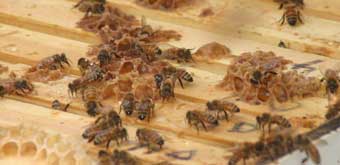WASHINGTON — Total losses from managed honey bee colonies nationwide were 30 percent from all causes for the 2010/2011 winter, according to the annual survey conducted by the USDA and the Apiary Inspectors of America (AIA).
Similar losses
This is roughly similar to total losses reported in similar surveys done in the four previous years: 34 percent for the 2009/2010 winter; 29 percent for 2008/2009; 36 percent for 2007/2008; and 32 percent for 2006/2007.
“The lack of increase in losses is marginally encouraging in the sense that the problem does not appear to be getting worse for honey bees and beekeepers,” said Jeff Pettis, an entomologist with USDA’s Agricultural Research Service (ARS) who helped conduct the study.
“But continued losses of this size put tremendous pressure on the economic sustainability of commercial beekeeping.”
Pettis is the leader of the Bee Research Laboratory operated in Beltsville, Md., by ARS, the chief scientific research agency of USDA.
Average loss, 38%
The survey covered the period from October 2010 to April 2011.
Beekeepers reported that, on average, they felt losses of 13 percent would be economically acceptable. Sixty-one percent of responding beekeepers reported having losses greater than this.
Average colony loss for an individual beekeeper’s operation was 38.4 percent. This compares to an average loss of 42.2 percent for individual beekeepers’ operations in 2009/2010.
Average loss by operation represents the percentage of loss in each operation added together and divided by the number of beekeeping operations that responded to the survey.
Small beekeeping
This number is affected more by small beekeeping operations, which may only have 10 or fewer colonies, so a loss of just five colonies in a 10-colony operation would represent a 50 percent loss.
Total losses were calculated as all colonies reported lost in the survey divided by the total number of bee colonies reported in the survey. This number is affected more by larger operations, which might have 10,000 or more colonies, so a loss of five colonies in a 10,000-colony operation would equal only a 0.05 percent loss.
Among surveyed beekeepers who lost any colonies, 31 percent reported losing at least some of their colonies without finding dead bee bodies — one of the symptoms that defines Colony Collapse Disorder (CCD).
Symptom
As this was an interview-based survey, it was not possible to differentiate between verifiable cases of CCD and colonies lost as the result of other causes that share the “absence of dead bees” as a symptom. The cause of CCD is still unknown.
The beekeepers who reported colony losses with no dead bee bodies present also reported higher average colony losses (61 percent), compared to beekeepers who lost colonies but did not report the absence of dead bees (34 percent in losses).
A total of 5,572 beekeepers, who manage more than 15 percent of the country’s estimated 2.68 million colonies, responded to the survey.
Analysis
A complete analysis of the survey data will be published later this year. The abstract can be found at www.extension.org/pages/58013/honey-bee-winter-loss-survey .
More information about CCD can be found at www.ars.usda.gov/ccd











This is more of a concern; why we are facing such huge losses on annual basis. There should be some measures developed instantly to control this situation. It’s really strange that no one has a real answer right now. I hope someone figures this out before it’s too late.
http://www.panna.org/sites/default/files/Memo_Nov2010_Clothianidin.pdf
It is almost too late.
I had 22 hives. In one week I have loss 4. The dead bees were in front of the hive by the thousands. When I checked them just over a week ago they had honey and brood.
Henry Wiemann ,
Commercial bee keeper of Colorado. The honey bee industry really needs to look at what the father of bee keeping(Huber) said about the development of the honey bee from the egg to its adult form and also the size of the honey bee cells. We have indeed modified the size of comb and bee. One note of interest is that drone comb could be as small as 5.4 mm. ( this cell size is what some of our commercial comb is) To the natural bee keeper that would be called psuedo drone cells. We know that any time we change what nature does we will run into inevidable consequences.